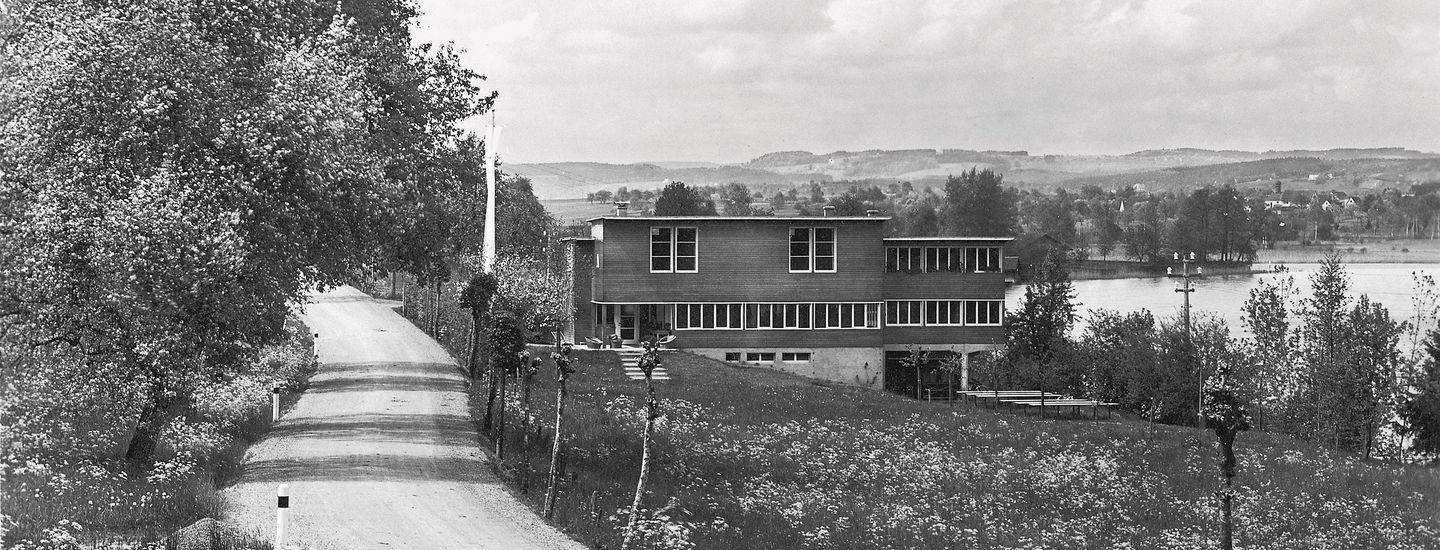
1947 to 1959
Recovery and professionalisation
«Regarding the installation of electricity, we would like to inform you that Sapün is planning to build a power plant. If this were to happen, we would also supply the youth hostel with electricity. That would be welcome because of the fire hazard, as most young people don’t know how to use a wood stove, nor do they know how to use kerosene lamps.»[1]
A change in travel habits
Some youth hostels are no longer rented out, including the Engler family’s “Heimeli” in Sapün, which is still operated as a mountain inn today.
After the end of the war in 1945, trips abroad are rarely possible and occupancy rates remain low until 1947. In 1948, the World Youth Peace League organises an international summer camp at Rotschuo Youth Hostel with representatives from ten nations. Four people from Germany also take part. In a resolution addressed to UNESCO, the young people «express their desire to support all efforts of countries to constitutionally establish the possibility of conscientious objection».[2] One year earlier, members from the Swiss youth hostels travel to Holland for two weeks to help rebuild the hostels there. International cooperation is slowly resumed and Switzerland is represented on the board of directors at the first post-war conference of the International Youth Hostel Federation (IYHF) in Scotland in 1946. The member countries decide to mutually recognise other national memberships. Switzerland was already represented at the founding meeting in 1932. From 20 to 22 October 1932, eleven European countries take part in the establishment of the International Youth Hostels Working Group.[3]
«Alas, the 25-years-old age restriction!»
Because the ban on hotel construction is still in force in Switzerland, the Swiss delegation must also maintain the age limit of 25 years for overnight guests in 1946. From the onset of the Great Depression in 1929, this age restriction helped to ensure that the youth hostels were not subject to the decree that had been in force since 1915, which stipulated that the construction of new hotels or the expansion of existing ones would only be possible with the approval of the Federal Council. The regulation is finally lifted in 1952 and four years later (1956) older guests are also allowed to spend the night in the Swiss Youth Hostels again.
From now on, what Federal Managing Director Otto Binder had to explain a few years earlier no longer applies: «Once a young person has reached the age of 25, they will no longer be able to enter the Swiss Youth Hostels as single travellers. However, they can also purchase a leader card for CHF 3, which entitles them to use the youth hostel in the company of a group of at least two young people under the age of 25.»[4] Here he is giving us a little tip. Despite the officially strict regulations, there were certainly opportunities for shrewd families to stay in a youth hostel if they had enough children in tow and were willing to pay a little more.
At the beginning of the 1950s, visitor numbers increase again and the number of overnight stays continues to rise. 1954 sees the last major polio epidemic in Switzerland, with 1,628 cases. School trips and holiday camps are repeatedly banned in the event of polio outbreaks and the effects are also felt by the youth hostels. A vaccine is not available until 1957, and the number of cases declines as a result. Today, Switzerland is officially polio-free.
Open to refugees – the promotion of peace and international understanding
Still feeling the effects of World War II, the President of the Swiss Youth Hostels states at the 1951 Annual Assembly: «All life is hiking. May hiking always be a movement that serves international understanding from country to country and thus peace.»[5]
Following the cessation of hostilities, the youth hostels also open their doors to displaced persons. This sometimes provokes resentment because the number of places is reduced, but most members understand the need. After the Hungarian uprising in 1956, some refugees find a temporary bed in a youth hostel.
This has been a tradition to this day. When many refugees arrived in Switzerland in 2015, 200 of them were temporarily accommodated in youth hostels that were closed to guests in winter. Shortly after Putin’s attack on Ukraine in 2022, the Swiss Youth Hostels immediately considered providing short-term accommodation and some municipalities also made use of this offer.
We travel in a way that suits us best
In the early 1950s, it was time to celebrate a birthday: Swiss Youth Hostels are turning 25. In his remarks in the annual report for 1950, which was expanded to mark the anniversary, President of the Federal Association Hans Hunziker mentions a situation that seems to be a thorn in the side of the now somewhat ageing management: Young people travel differently than a quarter of a century before. During the festive season, people fly from country to country. «Even the problem of cars parked in front of the youth hostels has become acute. The new era is bursting forth with vigour. But who wants to fight back? It would be futile.»[6] There has been a heated debate in the international association since 1949 as to whether guests travelling by car should be permitted to stay in youth hostels. Two years later, the same committee debates the admission of moped riders, and in 1954 the question of admitting groups travelling by bus stirs up some emotions. In the beginning, people had to travel «under their own steam» on foot or by bicycle. Travelling by train or the PostBus was also permissible. Can this change in mobility behaviour still be reconciled with the true spirit of the youth hostels? The majority recognise the signs of the times and say yes.[7] One thing is certain: «Our guests have also changed over the years. The former «Wandervogel» hikers with rucksacks and musical instruments now travel by hitchhiking, train and plane.»[8]
Discussions about correct mobility conduct are dragging on. It was not until 1968 that the German association lifted the overnight stay ban on motorists, with most countries following this decision.[9]
Families discover the youth hostel
It is not only the ways of arriving that are new, but also the composition of the guests. More and more families want to use the youth hostels. The age limit is finally lifted and new room layouts are now needed. Until now, girls and boys had to be kept separate, but the strict segregation of the sexes must now be lifted so that mother, father, daughter and son can sleep in the same room. There should be no more bunkbeds, which is why an attractively priced and modern bed is designed in 1955. In general, an attempt is made to bring some uniformity to the association, and in 1959 national guide prices for catering are drawn up for the first time and menu suggestions are made. The movement has evolved considerably from its origins as a youth organisation emphasising self-sufficiency and driven by young people, to a service-oriented company with a high degree of professionalism. This is also reflected in the language. The focus is not so much on togetherness but rather on people. In the 1959 annual report, the Executive Board states: «There is no point in criticising our young people today, lamenting their decline and glorifying and wishing back our ‘good old days’. (…) We can and must go with our young people today, because we want to help them in their development.»[10]
The first youth hostel movement in Germany from 1909 onwards was not an independent youth movement. Rather, it was spearheaded by adults, specifically 35-year-old teacher Richard Schirrmann and the conservationist Wilhelm Münker of the same age, who shared an educational vision. In contrast, the founders in Switzerland originated from the grassroots level. Many of them have been active for decades and have had to constantly redefine their roles. Gertrud Honegger, who had invited guests to the founding meeting of the girls’ home on Gartenhofstrasse, was an active member of the board of directors of both the Zurich Association and the umbrella organisation for almost 40 years until her death. Shortly before her fatal car accident, she participates in the International Conference of the IYHF. In 1974, Ernst Schuler, the first president, writes a history of the association for the 50th anniversary. Following his retirement in 1965, the Chairman manages the club’s administrative office on a half-day basis and in 1969 hands over the management of the Zurich board to Jakob «Jack» Kern. Seven years earlier, the 28-year-old Scout had been elected to the board of directors when the expansion of the hostel was being discussed at a time when Wollishofen Youth Hostel was being constructed. In 1973, he takes the next step and becomes the director of the newly founded Swiss Foundation for Social Tourism, which he manages until his retirement in 1999. He also survives the challenges of those pioneering days and has since become a legendary figure.[11]
[1] Brief von Gasthaus und Pension Heimeli an die Geschäftsstelle der Jugendherbergen Zürich, 20. Oktober 1952.
[2] From the Zeit newspaper 37/9 September 1948. Available at www.zeit.de/1948/37/notizen
[3] Germany, Switzerland, Czechoslovakia, Poland, Netherlands, Norway, Denmark, UK, Ireland, France and Belgium.
[4] Otto Binder, Jugendwander und Jugendherbergen in der Schweiz (Youth Hiking and Youth Hostels in Switzerland, Accompanying material to the travelling exhibition of the Swiss Youth Hostels Federation, undated, no page information.
[5] Hans Hunziker in 25 Jahre Schweizerischer Bund für Jugendherbergen (25 Years of the Swiss Federation for Youth Hostels), 1951, p. 11.
[6] Hans Hunziker in 25 Jahre Schweizerischer Bund für Jugendherbergen, 1951, p. 8f.
[7] Cf. Antje Günther, «Die Schweizer Jugendherbergen auf dem Weg in die Zukunft, Achtung, fertig, los», (Swiss Youth Hostels advancing towards the future – Ready, steady, go) diploma thesis 1991, p. 13.
[8] Heinz Lüdi, Federal President, 50 Jahre Verein für Jugendherbergen Zürich (50 Years of the Zurich Youth Hostels Association), p. 4.
[9] Anton Grassl and Graham Heath, The Magic Triangle, A Short History of the World Youth Hostel Movement, 1982, pp. 113—153, based on Antje Günther, «Die Schweizer Jugendherbergen auf dem Weg in die Zukunft, Achtung, fertig, los, diploma thesis» 1991, p. 14.
[10] Annual report 1959, NN
[11] Cf. blog.youthhostel.ch/er-lebt-seit-60-jahren-fuer-die-schweizer-jugendherbergen/










Share this page